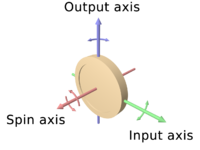BTW discussing the gyroscopic effect makes me think about those "flybrid" (flywheel hybrid) Porsche race car -- the one with the internal flywheel that rotates at several thousand rpm's. What do those flywheels do to the car's balance when you enter a banking curve? Will a "flybrid" car steer like a motorcycle? 
 See animation below.
See animation below.
"The behaviour of a gyroscope can be most easily appreciated by consideration of the front wheel of a bicycle. If the wheel is leaned away from the vertical so that the top of the wheel moves to the left, the forward rim of the wheel also turns to the left. In other words, rotation on one axis of the turning wheel produces rotation of the third axis."
>>>>>>>>>>>>>>>>>>>>>>>>>>
http://en.wikipedia.org/wiki/Gyroscope
A gyroscope is a device for measuring or maintaining orientation, based on the principles of conservation of angular momentum.[1] A mechanical gyroscope is essentially a spinning wheel or disk whose axle is free to take any orientation. This orientation changes much less in response to a given external torque than it would without the large angular momentum associated with the gyroscope's high rate of spin. Since external torque is minimized by mounting the device in gimbals, its orientation remains nearly fixed, regardless of any motion of the platform on which it is mounted. Solid state devices also exist, such as the ring laser gyroscope.
Applications of gyroscopes include navigation (INS) when magnetic compasses do not work (as in the Hubble telescope) or are not precise enough (as in ICBMs) or for the stabilization of flying vehicles like Radio-controlled helicopters or UAVs. Due to higher precision, gyroscopes are also used to maintain direction in tunnel mining [1].
Description and diagram

Diagram of a gyro wheel. Reaction arrows about the output axis (blue) correspond to forces applied about the input axis (green), and vice versa.
Within mechanical systems or devices, a conventional gyroscope is a mechanism comprising a rotor journaled to spin about one axis, the journals of the rotor being mounted in an inner gimbal or ring, the inner gimbal being journaled for oscillation in an outer gimbal which in turn is journaled for oscillation relative to a support. The outer gimbal or ring is mounted so as to pivot about an axis in its own plane determined by the support. The outer gimbal possesses one degree of rotational freedom and its axis possesses none. The inner gimbal is mounted in the outer gimbal so as to pivot about an axis in its own plane that is always perpendicular to the pivotal axis of the outer gimbal.
The axle of the spinning wheel defines the spin axis. The inner gimbal possesses two degrees of rotational freedom and its axis possesses one. The rotor is journaled to spin about an axis which is always perpendicular to the axis of the inner gimbal. So, the rotor possesses three degrees of rotational freedom and its axis possesses two. The wheel responds to a force applied about the input axis by a reaction force about the output axis.
The behaviour of a gyroscope can be most easily appreciated by consideration of the front wheel of a bicycle. If the wheel is leaned away from the vertical so that the top of the wheel moves to the left, the forward rim of the wheel also turns to the left. In other words, rotation on one axis of the turning wheel produces rotation of the third axis.
A gyroscope flywheel will roll or resist about the output axis depending upon whether the output gimbals are of a free- or fixed- configuration. Examples of some free-output-gimbal devices would be the attitude reference gyroscopes used to sense or measure the pitch, roll and yaw attitude angles in a spacecraft or aircraft.

Animation of a gyro wheel in action
The center of gravity of the rotor can be in a fixed position. The rotor simultaneously spins about one axis and is capable of oscillating about the two other axes, and thus, except for its inherent resistance due to rotor spin, it is free to turn in any direction about the fixed point. Some gyroscopes have mechanical equivalents substituted for one or more of the elements, e.g., the spinning rotor may be suspended in a fluid, instead of being pivotally mounted in gimbals. A control moment gyroscope (CMG) is an example of a fixed-output-gimbal device that is used on spacecraft to hold or maintain a desired attitude angle or pointing direction using the gyroscopic resistance force.
In some special cases, the outer gimbal (or its equivalent) may be omitted so that the rotor has only two degrees of freedom. In other cases, the center of gravity of the rotor may be offset from the axis of oscillation, and thus the center of gravity of the rotor and the center of suspension of the rotor may not coincide.
--
Regards,
Can
997 Turbo + Bilstein Damptronic "Stage 2" ( Review ) + GIAC ECU Tune ( Fast as a torpedo & reversible to stock - Review ) + Cargraphic Exhaust ( Oh heavenly noise!  )
)


 Close
Close